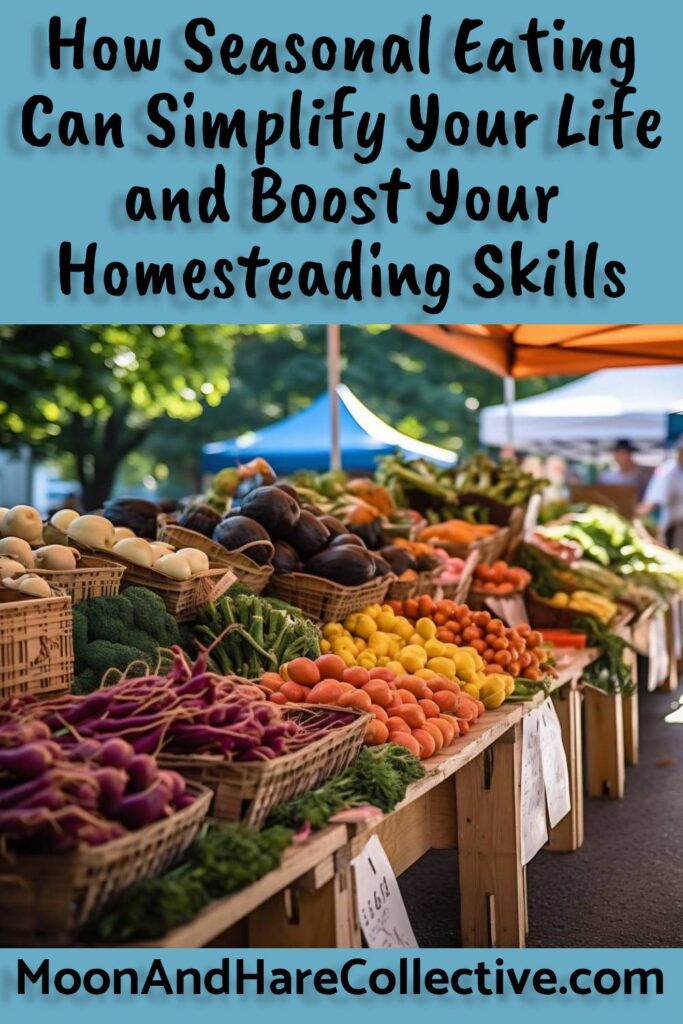It’s so easy these days to stroll through the grocery store and pick up whatever you feel like eating- regardless of what the season is. Do you want to eat strawberries in the middle of winter? Do you want to eat winter squash in the summer? These are readily available – though their flavor and nutritional value are very questionable.
One of the things that modern homesteaders strive to do is live with the seasons. I think this is really a pragmatic choice that makes life a lot easier when you have massive (or even small but overwhelming) amounts of produce to deal with. So this is one more step that you can take toward your homesteading goals.
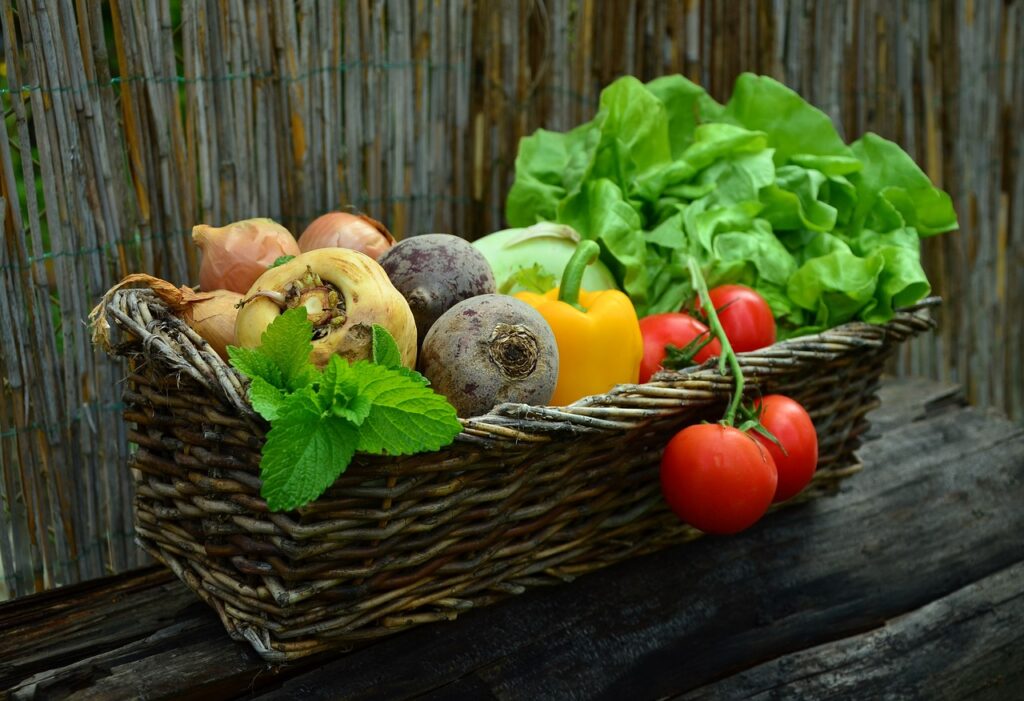
You can totally take small steps toward this goal. I highly recommend small steps so you don’t get overwhelmed and stressed out and give it all up. You don’t have to chuck out all your old food and not let anything unseasonal in your house. Just start adding seasonal meals and slowly, over time, the unseasonal will lose its appeal.
Out of season produce is shipped from far away causing environmental harm through transportation. Most is picked before it’s ripe, reducing its nutrient content and most importantly, its flavor.
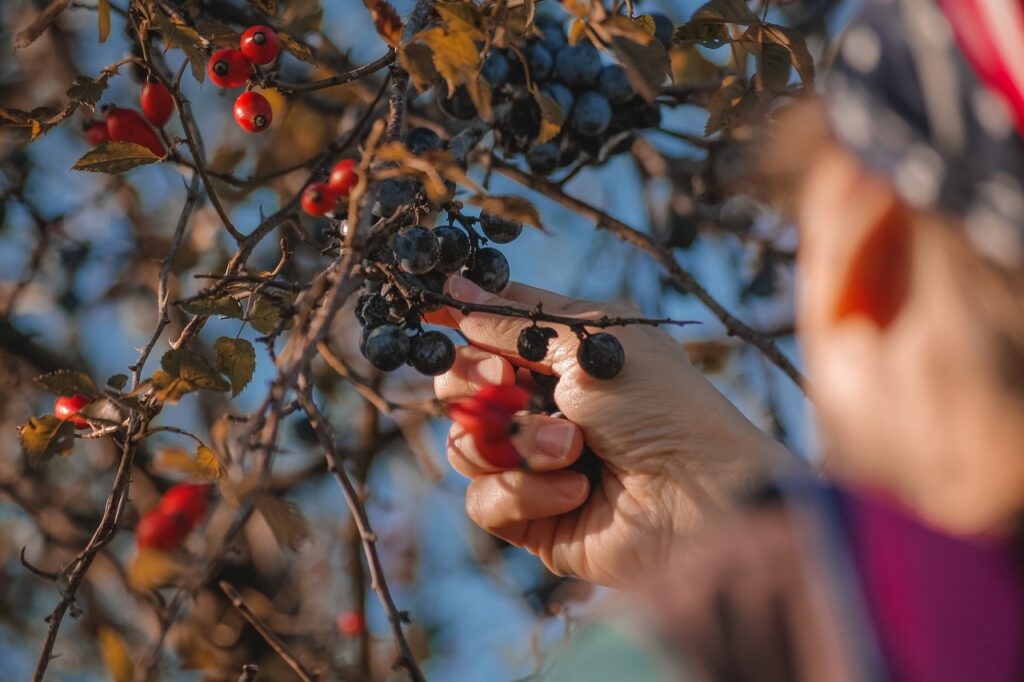
Eating seasonally means enjoying foods that are harvested at their best during the time of the year when they’re ripest. You get fresher, tastier, more nutritious produce because you’re eating it when it’s at its peak. By sticking to what’s in season, you can cut down on your environmental footprint, support local farmers, and even save some money. It also keeps your meals more interesting and changeable over the year. Seasonal diversity makes for delicious eating all around. If you’re growing your own produce, you can focus on what’s in your own backyard. If you purchase from a farmer’s market, it’s super easy to stick with seasonal produce, by just purchasing what’s available.
One thing that’s important to me as a modern homesteader, is living with the seasons in whatever ways that I can. Seasonal eating is just one part of that. For me, seasonal eating helps create a deeper connection with nature and with my food, and encourages me to be more mindful. Seasonal eating promotes creativity in the kitchen, since I’m using what I have available. It’s a lot of fun to learn new recipes that focus on whatever is freshest and most vibrant.
Another reason that I like to eat with the season is that I don’t like most preserved food. It’s just not the same. Sometimes it’s not even a shadow of its original form. Canned green beans? Frozen corn on the cob? No thanks. I want these foods in season so that I can enjoy them at their best and most flavorful. Then, I don’t feel bad if all we eat are strawberries for a month, but then we don’t get them again for a whole year. It helps me appreciate the deliciousness when it’s available.
I do preserve food
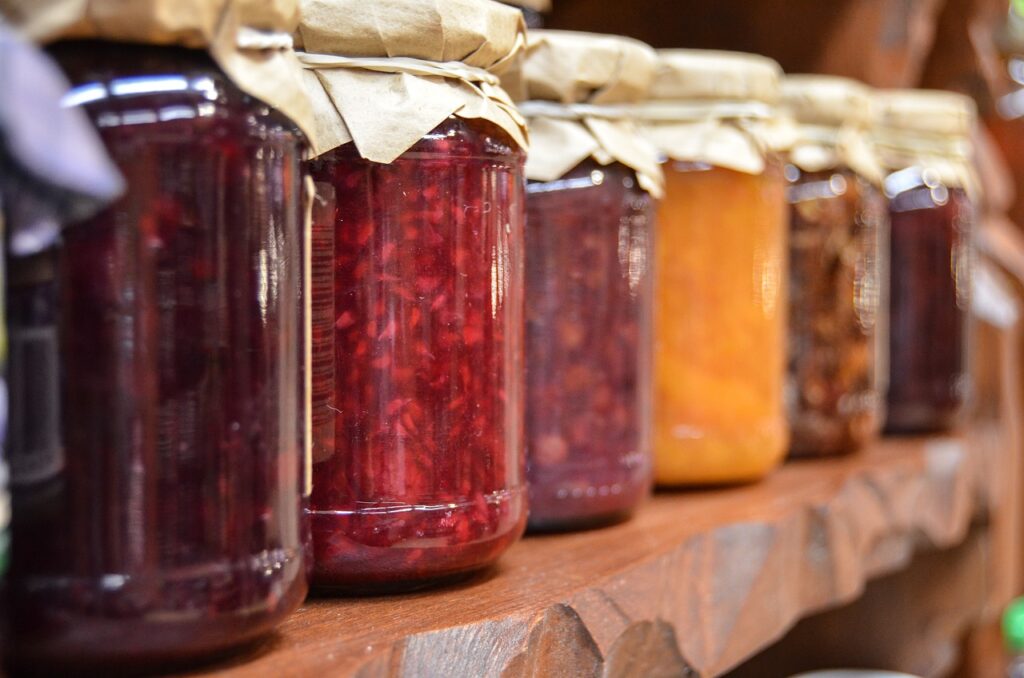
Now don’t get me wrong – I do a lot of preserving. I can tomato sauce so we can eat spaghetti all winter long. In the summer though, I make a fresh sauce. Some foods are just as good and just as nutritious in their preserved form – like frozen broccoli and cauliflower. And this is all important because in the winter, there’s a lot less variety of produce available. That’s part of seasonal eating too. I’ll get into that in a bit.
How to eat seasonally?
If you’re new to eating seasonally, it may take a little adjusting. You may need to learn new recipes. You may need to accustom yourself with what’s in season in your area.
Farmer’s Market
A really good way to do that is to make a weekly trip to the farmer’s market. Typically they only have what’s in season, so it’s really easy to just look at the bounty and choose what you want.
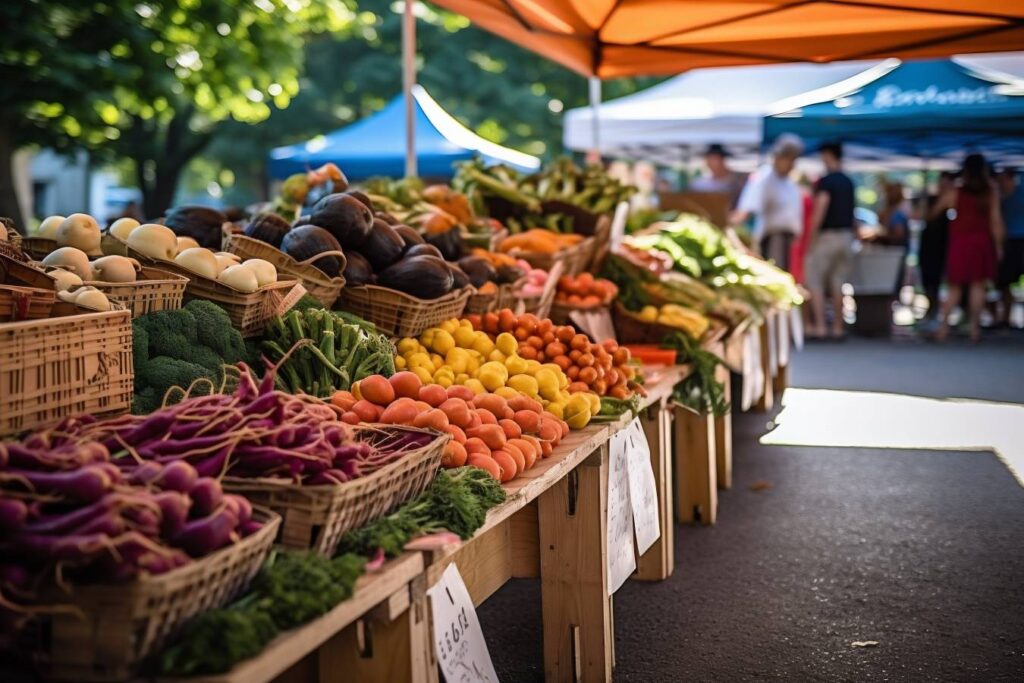
Local Farms
Do you have local farms near you? Head out for an afternoon in the country and get some produce. In my experience, the farms are less expensive than farmer’s markets.
Gardening
If you’re a gardener, that’s another really easy way to keep up with the seasons. If it’s ripe, it’s in season. That’s pretty easy. This is the least expensive way to get seasonal produce. If you don’t have enough variety because of how well things grew for you- maybe you can trade with neighbors! If you have a bumper crop of cucumbers this year, trade some away for zucchini or something you don’t have as much of!
Community Supported Agriculture (CSAs)
Another way to eat in season is to join a CSA. Much like farmer’s market, a CSA will give you only produce that is in season. CSAs may be cheaper than farmer’s market too. And they come with the delightful challenge of using whatever you receive in your box that week. It may take a little more learning if you get something you’ve never cooked before, but it’s a great way to get to know different foods that you might not otherwise try.
Lists online
There are lists online that you can find that will show you what’s in season in your area. Make sure you check by your area though.
Local Stores
Some local stores will source their produce from local farms. Ask around and see what how far away they’re getting their produce from and you can make a choice based on what they say. In the grocery store, seasonal produce will most likely be that which there is a lot of, and it will be on sale because it’s less expensive and more abundant.
Seasonal eating looks very different by the season.
Spring
In spring, things are just beginning. This is when you’re planting seeds or buying starts and just putting the garden together. The food focus is on light and bright foods. In my zone, there will be a lot of greens available. Asparagus starts to make a show. Spring potatoes might be available. In late spring, there will be strawberries. Rhubarb, spinach, ramps, and fiddlehead ferns are in season.
Summer
Summer is the heyday of food. Fruits and vegetables abound. It’s easier to ask what *isn’t* available rather than what is!
Cucumbers, zucchini, tomatoes, eggplant, peppers, and a lot of fruit, like blueberries and peaches. Melons will also be ready in late summer.
Fall
In the late summer and the fall, it’s time to focus on harvesting and preserving produce so you can have a larger variety through the sparse winter months. A lot of my time and energy goes into canning, freezing, and dehydrating.
Winter squash, pumpkins, potatoes and other root veggies will all start to be available in fall. You’ll likely find cauliflower, broccoli, and cabbages as well. Apples will also start to be available. Many of these foods will store well.

Winter
There are things that will grow in winter, or may grow up until a few hard frosts. You can eke out a few fresh produce meals, but the focus is on preserved and stored foods. This is when I like a lot of warm and cozy meals, like soups and pasta.
What about foods that don’t grow in my area?
Some people choose not to eat foods that don’t grow in their area. I completely understand this, but I’m not willing to give up deliciousness like pineapple and avocados. However, you can still purchase these items when they’re in season. You still get all the benefits of seasonal eating – they’re generally more available and less expensive when they’re in season. The other bonus is that a lot of those rarer foods for my area are in season in winter, which means we can add to our variety in the season where there’s less local stuff. We do use these more sparingly, even in season because they do have to be transported from quite a distance, and they pretty much need to be bought in a grocery store.
How do I use the food?
Just eat it
Many seasonal foods are just amazing and delicious the way they are. Fruits for the most part. I mostly eat these foods fresh, but I will preserve some to bake or cook in things for the winter months.
Let your intuition be your guide
You’ve been eating your whole life. What do you like? How do you like to prepare foods? What cooking skills do you already have? It doesn’t have to be complicated. Some foods seem to be naturally cooked in some way – like vegetables just seem easy and delicious simply steamed or roasted.
Find recipes
Of course I have a growing recipe collection on this site – and there are so many more websites out there. And books. It’s never been easier to find a recipe. What produce do you have? Go to google and search for “green bean recipes” or “tomato and pepper recipes” and a whole bunch will come up! Add on the word easy or quick and you’ll get a whole bunch of choices. This is where it’s fun to experiment! There’s so many options, so be careful you don’t get overwhelmed!
Don’t forget to preserve some!
Winter often brings fewer produce choices, and your local farms and farmer’s market may even shut down for a while. You may want to learn how to can, freeze, dehydrate, or otherwise preserve foods while they’re in season so that you can have variety and flavor on your plate during the sparser winter months as well.
How can I meal plan with seasonal eating?

I get it. Meal planning is super important for frugal eating. Plus, I just like to have a plan, otherwise I get super overwhelmed and end up ordering take out.
One idea is to plan your meats or proteins for the week and then just add the seasonal veggies that are available at the market that week. That totally works, but it leaves things a little up in the air. Especially if you accidentally don’t get enough produce to last the week.
I like to have a plan. I have a hard time functioning without a plan. So I have created a general theme of our meals for the week, and then I fit what’s seasonal in there. I don’t generally have a season for meats, though humans used to eat meat seasonally as well. These days meat animals are butchered as there is a need, since we have modern conveniences like refrigerators and freezers to keep it safe and retain the nutrients. However, you’ll see remnants or our seasonal meat-eating history in traditional dishes – like how turkey is served at Thanksgiving, or ham at easter. In fact, traditional meals are a great way to learn about seasonal eating. The reason that the foods were eaten then is because that is when they were harvested or butchered. But I digress….
So I have a list of thematic or types of food that we eat during the week. I have one for fall and winter – because I am more interested in pasta and soups in the colder months, and I have one for spring and summer with lighter fare. You can read more about that in my post on seasonal meal planning.
Then, I plan my meals around whatever meat I’ve chosen for that day and the produce that is available. To see what’s available, I use whatever I’m harvesting from the garden, or what I’ve purchased from the farmer’s market. For planning purposes, you can look up what’s in season in your area this website.
What about lunches and snacks?
I don’t plan lunches and snacks. However, I do fill the refrigerator with all the produce from the yard every couple days. My kids eat cucumbers and tomatoes for snacks. Also, I keep hard boiled eggs, cheese cubes, and hummus in the fridge, so there are lots of choices available.
Seasonal eating isn’t just about what’s on your plate—
it’s a way to stay in tune with nature and enjoy food at its best. When you eat with the seasons, you’re getting the freshest, most flavorful produce while supporting local farmers and cutting down on your environmental impact. It makes cooking more fun, too, since you’re always working with whatever’s freshest and most vibrant. Whether you’re picking up veggies from a farmer’s market, tending your own garden, or diving into a CSA box, eating with the seasons keeps you connected to nature and makes your meals something to look forward to. Plus, you’ll find yourself appreciating those special treats when they’re in season, like strawberries in summer or asparagus in spring. Give it a try and see how your relationship with food transforms!

